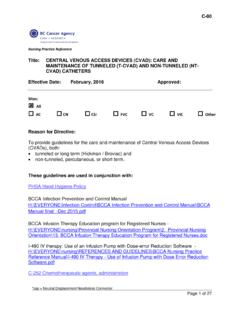Transcription of Title: CENTRAL VENOUS ACCESS DEVICES (CVADs): CARE …
1 C-75 Nursing Practice Reference title : CENTRAL VENOUS ACCESS DEVICES (CVADs): CARE AND MAINTENANCE OF IMPLANTED VENOUS ACCESS DEVICES (IVADs) Effective Date: February, 2016 Approved: Sites: All AC CN CSI FVC VC VIC Other Reason for Directive: To provide guidelines for the care and maintenance of Implanted VENOUS ACCESS DEVICES (IVADs). An IVAD may also be referred to as a port or Port-a-Cath . These guidelines are used in conjunction with: PHSA Hand Hygiene Policy BCCA Infection Prevention and Control Manual H:\EVERYONE\Infection Control\BCCA Infection Prevention and Control Manual\BCCA Manual final -Dec BCCA Infusion Therapy Education program for Registered Nurses - H:\EVERYONE\nursing\Provincial Nursing Orientation Program\2.
2 Provincial Nursing Orientation\13. BCCA Infusion Therapy Education Program for Registered I-490 IV therapy: Use of an Infusion Pump with Dose-error Reduction Software - H:\EVERYONE\nursing\REFERENCES AND GUIDELINES\BCCA Nursing Practice Reference Manual\I-490 IV Therapy - Use of Infusion Pump with Dose Error Reduction C-252 Chemotherapeutic agents, administration BCCA ST Policy III-20 Prevention and Management of Extravasation of Chemotherapy BCCA ST Policy III-80 Assessment of Needle Placement / Catheter Patency in CVC DEVICES VCH-Blood Collection Quick Reference Guide *cap = Neutral Displacement Needleless Connector Page 1 of 23 C-75 H.
3 \EVERYONE\nursing\EDUCATION CENTRAL VENOUS ACCESS DEVICES - Naturopathic Doctors: CENTRAL VENOUS ACCESS DEVICES : Naturopathic Doctor Position Statement H:\EVERYONE\nursing\EDUCATION\ CENTRAL VENOUS ACCESS DEVICES - Naturopathic Doctors\Naturopathic Doctor Position Patient handout: Naturopathic Doctor- Use of CENTRAL VENOUS ACCESS DEVICES FAQ H:\EVERYONE\nursing\EDUCATION\ CENTRAL VENOUS ACCESS DEVICES - Naturopathic Doctors\Naturopathic Doctors - CENTRAL VENOUS ACCESS DEVICES NOTE for Midline Catheters: Midlines are not recommended for use at BCCA because of the difficulty in detecting infiltration or extravasation, and the risk of complications.
4 Midline catheters are peripheral infusion DEVICES with the tip terminating in either the basilic, cephalic, or brachial vein, distal to the shoulder. The catheter tip does not enter the CENTRAL vasculature. If no other vascular ACCESS is possible, refer to NPR I-390, Directive 19, page 4 for more information on appropriate and inappropriate infusates. Index Page(s) DIRECTIVES Clinical Competency Validation 3 Patient Education 3 Features: Single / Multi-lumen, Valved, Non-Valved, Power-capable 3 Insertion/Removal 4 Documentation and Reporting: Type of IVAD, Care, PSLS 4 Infection Prevention and Control: Sterile Aseptic Technique and 3-swab-no-touch-technique 5 Dressings: Post-operative Care 6 Infusion Equipment 6 Preventing Air Embolism 7 Maintaining Patency.
5 Pulsatile and Positive Pressure Techniques 7 IVAD Damage 8 PROCEDURES Accessing and Flushing an IVAD 8 Initiating an Infusion 10 Completing an Infusion 11 Drawing Blood Specimens 11 De-accessing an IVAD 13 MANAGEMENT OF POTENTIAL IVAD OCCLUSION - PARTIAL AND COMPLETE Standard Trouble-Shooting Process 14 Management of Occluded IVADs with Alteplase 15 Skin Patch Test 17 REFERENCES 18 APPENDIX A Patient Information Handout: Implanted VENOUS ACCESS Device 20 *cap = Neutral Displacement Needleless Connector Page 2 of 23 C-75 DIRECTIVES: Clinical Competency Validation: The Registered Nurse (RN) /student nurse must have completed the BCCA Infusion Therapy Education Program for RNs and subsequent skill validation in order to perform any procedure on a cvad .
6 Patient Education: To include schedule for care and management, role in self-care, signs, symptoms and potential for infection and occlusion and when, how and to whom to report changes. Standard BCCA materials related to self-care of IVADs will be used. Patient Information Handout for IVADs is located in Appendix A. Features: Single or multi-lumen: Each lumen of a multi-lumen IVAD is treated as a separate catheter. Recommend that where possible, the largest (gauge) lumen be used for blood sampling, blood product administration and administration of viscous or high volume fluids.
7 Valved: A valve is present near the distal tip of the catheter or proximally, adjacent to the septum. Clamping is not required as the valve is closed except during infusion or aspiration. Non-Valved: The catheter is open at the distal tip. The catheter requires clamping before ACCESS and de- ACCESS of the system. Huber needle sets must have clamps built in to allow for clamping of the line. Power Capable DEVICES : RNs may carry out routine care for any IVADs including identifying a power IVAD and accessing for power injection of contrast.
8 No special care needs unless the IVAD is being used for power injection for diagnostic imaging purposes. Power IVAD compatible pressure-rated needle and special tubing is needed to withstand the higher intraluminal pressures generated during power injection. NB: If an IVAD is unfamiliar, contact the manufacturer s clinical support line to determine device care or obtain device policy from the insertion facility. *cap = Neutral Displacement Needleless Connector Page 3 of 23 C-75 Insertion/Removal: An IVAD must be inserted by a physician.
9 The catheter tip is ideally located in the junction between the superior vena cava (SVC) and right atrium. Confirmation of tip placement by x-ray or fluoroscopy is done at time of catheter insertion. An IVAD may be used immediately following insertion. IVADs are usually removed by a physician when - Therapy is completed The catheter is malpositioned ( pinch-off syndrome) The tip is no longer within the SVC The catheter is damaged The patient has developed a catheter-related infection Documentation and Reporting: Type of IVAD: The first nurse, prior to ACCESS of an IVAD is responsible for documenting the following on the ALERT form in the patient record.
10 Date of insertion Type of device Valved, or non-valved Need for heparin The source of the information ( operative report or the patient s wallet card) Documentation of Care: All procedures performed on a IVAD will be documented using the appropriate documentation forms and should include, but is not limited to: Condition of the site, type of dressing and needle is in-situ Procedures and interventions performed For multi-lumen catheters, identify the lumen being referred to Patient response including symptoms, side effects or complications Patient and/or caregiver education Patient Safety Learning System (PSLS): The RN should document and report unresolved obstruction, extravasation, air embolism, infection, catheter damage and product defect using the PSLS.












